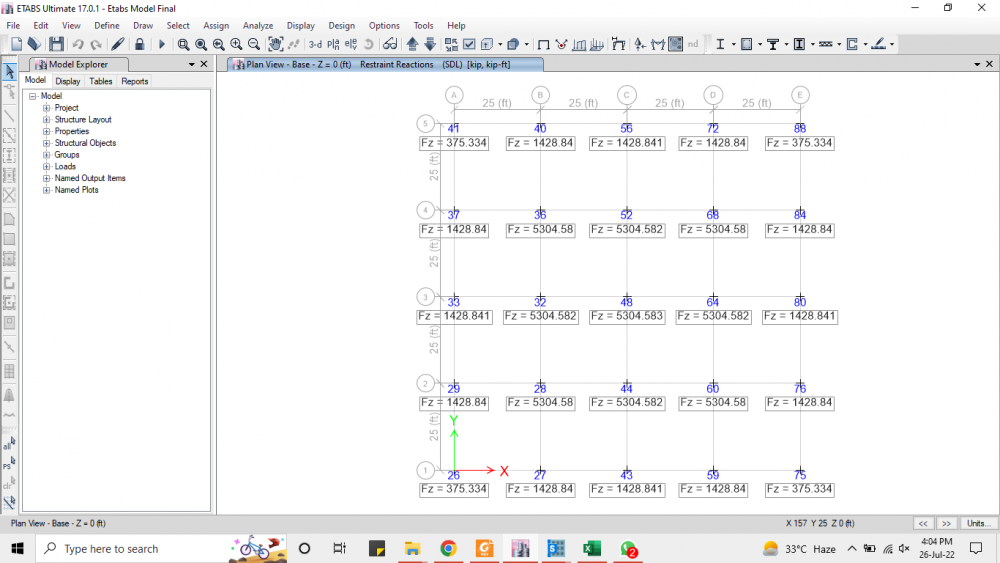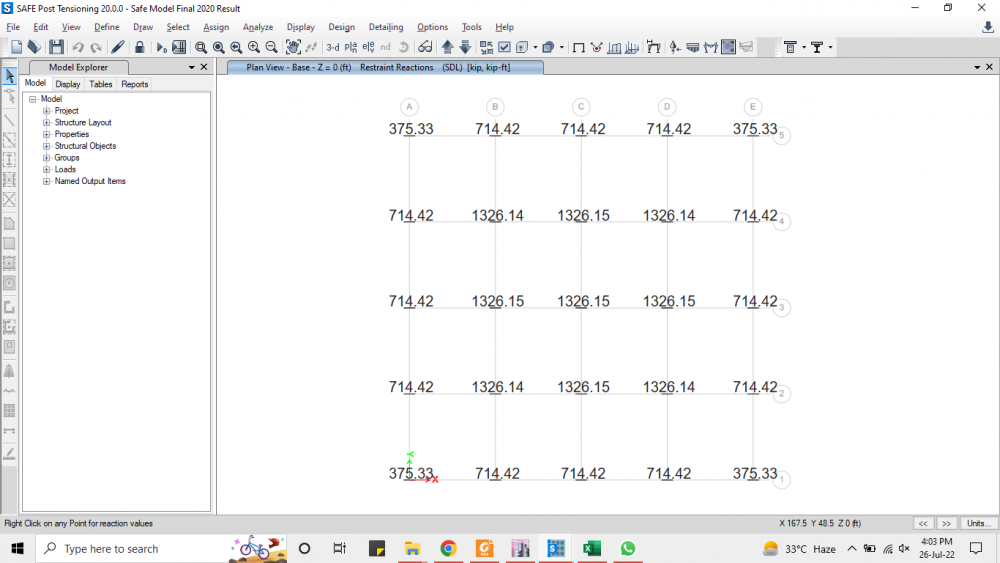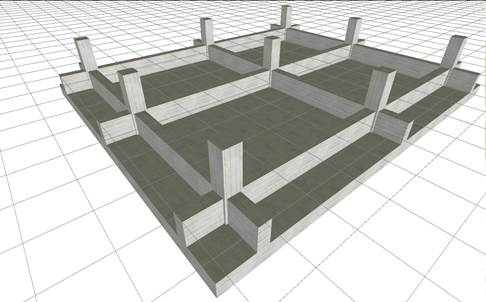Search the Community
Showing results for tags 'Foundation'.
-
Greetings Everyone, I am doing a case study for validating the results of ETABS and SAFE using same input data. I am using ETABS 2017v and SAFE 2020v. I have assumed same data to be modeled and analyzed in both software. I have been trying to figure out the difference in my results but no use. I am providing the input data for reference for correction. I have modeled 4 bays (in both x and y directions) with 25' each. Drawn the raft section on grids. I am modeling raft for 10 stories but I will model single story and multiply my loads with 10 for just comparison. RAFT=24"; Slab=6"(for self weight calculation); Modulus of Subgrade reaction=240kip/ft2/ft (Assumed); SDL=90psf; LL=40psf All the loads are factored [(1.2 dead load)+(1.6 live load)] applied as point loads on joints. I have 3 types of joints (Corner, Middle, Edge joints) with their corresponding contributing areas. The loads come to be Corner Joint Loads=410kips; Edge Joint Loads=820kips; Middle Joint Loads=1630kips All loads are assigned under the load pattern of SDL. I have also provided size of load for punching shear X=36"; Y=36". Assigned all raft sections area spring with stated data in direction 3 and compression only. Ran the analysis and displayed base reactions. Results were not matching. I had to explain all the steps so to convey my message properly. KEYPOINT: I am assuming that the inconsistency is coming from the assignment of area springs. Because in ETABS the input data is "Spring Constant/ Unit Area" while in SAFE it is directly defined by the Modulus of subgrade reaction. I even tried to multiply the subgrade modulus with their tributary areas and assigned to their respective areas in ETABS but no use. RESULT VARIATION (Screenshots Attached): The corner joints in both ETABS and SAFE are providing consistent results. The edge joints of ETABS have double base reactions to that of SAFE. The middle joints of ETABS have four times the reactions of SAFE. ANOTHER CLEARIFICATION: I also tried in SAFE v12 and SAFE v16 but I am unable to display the base point reactions in those versions with the same model I was able to display them in Version 20. Thanks and regards, Muhammad Fawad Khan. B.Sc. Civil Engineering UET Peshawar. Etabs Model Final.EDB Safe Model Final 2020 Result.FDB
-
- area springs
- foundation
-
(and 2 more)
Tagged with:
-
For calculating the bearing capacity of soil (using N values), the equations for mat foundation and single footings is the same or its separate for each??
- 3 replies
-
- bearing capacity
- foundation
-
(and 1 more)
Tagged with:
-
assalamualaikum sepakistan usersi wanna ask what are the considerations of using this ribraft foundation thing?what are the advantages and disadvantages?what are some load applied on it?how do we design the slab and the beam?thank you.
- 5 replies
-
- raft
- foundation
-
(and 1 more)
Tagged with:
-
Salam to all, Is there any rules to depth of foundation(Df) Say, I need MAT foundation on SBC=1.43 ksf. what would be the depth of Mat Foundation (Df) from Existing Ground Level.
-
Dear All, I have recently designed Raft foundation for 6 story building in SAFE. I have 4 feet offset area on site and have already spread the raft upto 4 feet offset edges. The SBC is 17000 lb per sq.ft. I created uplift load cases according ACI-318-08 as shown in the attached picture. After analysis I observe that the uplift pressure is negative but the magnitude exceeds SBC. I watch many tutorials where negative results are considerd safe but I am still confuse whether is it Ok or I should reduce the result. Please match the SAFE results with the mentioned SBC and answer this topic. Thanks in advance.
- 2 replies
-
- foundation
- raft
-
(and 2 more)
Tagged with:
-
AOA. 1) I have a question regarding steel reinforcement in wall footing. under which condition we should use steel in wall footing. 2) For Rc wall ( if in compound wall) we have to steel reinforcement all the time in footing or not ??
-
DEAR SIR, can you please tell me, Why foundation is designed for STATIC LOAD CASES only. Why not we design foundation for RESPONSE SPECTRUM CASES. In our office for G+24 also we design foundation only for STATIC LOAD CASES, is it wrong if we do foundation for static load cases
-
Dear fellow engineers, In a refugee camp reconstruction, we have the following dilemma: First, we have an existing retaining wall, height up to 4.5 meters, thickness ranging from 0.25 to 0.4 m. On the back of the wall we have existing an layer of cyclopean concrete :height up to 4.5, width 3m, and length along the wall. A 5 story building is to be built over the cyclopean concrete. This means that the Raft of the building (0.5m thick) will lie directly above the existing wall. The question is, what is the calculation required to ensure that this wall will withstand the loads of the raft?
-
Assalamu Aalikum, Hi, I am a new member. I have a plot measuring 30*70 feet. Most of houses being built here (in Rawalpindi) have masonry foundations (a pyramid of bricks on PCC or sometimes the PCC layer has three to four iron rods of size 3/8 or 4/8 in this "PCC" layer. I want to make a raft foundation instead of masonry foundation but the cost seems to be high. I want to ask if I make a raft 1 feet thick and put a single mesh of center to center distance 12 inch. Even this will cost more but if it gives more strength then I want to go for this. Would such foundation more durable and strong?
- 3 replies
-
- foundation
- mat
-
(and 2 more)
Tagged with:
-
From engineering point of view, it is really very amazing to see a complete city builtup in water ways, in a lagoon. How did they make the foundation system of buildings completely all the time underwater? Really interesting article here is. It also explains some modern challanges to the city i.e. flooding due to raised levels of sea and an inteseting solution to this problem. https://sites.google.com/site/engineeringvenice/
- 1 reply
-
- piles
- foundation
-
(and 3 more)
Tagged with:
-
High Loads under Columns and Bearing Capacity Failure
muneeb1213 posted a topic in Foundation Design
I m designing a 4 storey building on a poorly graded sand with SPN value of 5 and allowable bearing capacity of 0.5 tonn/sq.ft..... for the mat foundation, i provided beams of 18 x 36 and mat thickness as 24 inches ... however the soil pressure are still above safe bearing capacity.. My question is should i assign line spring property to the footing beams or not??? The area of footing is also increased but the stresses are still high...- 12 replies
-
- foundation bearing failure
- foundation
-
(and 1 more)
Tagged with:
-
Assalam o alaikum, i m confused whether collectors and chords are only required in Flat plates/slabs or also required in beam slabs? because in beam slab we are having beams at perimeter of every panel and they can act as chords and for diaphragm bending and as collectors at junction of slab to shear wall. Usually, in seismic zone 4, i dont design diaphragm exclusively. i just design it as simple slab and design my beams in SMRF or Dual Frame in etabs. Also i m confused in excerpt from a document stating The Special Seismic Load combination is also indirectly identified in Chapter 18, Section 1809, Foundation Construction – Seismic Zones 3 and 4. 1809.3 Superstructure-to-Foundation Connection. The connection of superstructure elements to the foundation shall be adequate to transmit to the foundation the forces for which the elements were required to be designed. For instance, since Section 2213.5 Column Requirements specifically identifies the Ω0 factor, Section 1809.3 requires the column-to-foundation connection to be designed for a load combination which includes the Ω0 factor. What does it mean? In seismic zone 3 or 4, we need to design foundations for special seismic combos ALWAYS or only if we r having discontinuous system? The full document is also attached. Thanks. OmegaFactorDiscussion.pdf
- 3 replies
-
- collectors
- omega
-
(and 5 more)
Tagged with:
-
kindly reccomend me a book or software for pile designing...
-
Assalam o alaikum seniors, I am searching for some design example of TIE BEAM DESIGN.... I am having sap reactions of all the columns.. I need detail of manual design of tie beam. Or info how to design it. I also want to design it for differential settlement of columns and for lateral loads also... How shud i take these loads in my design??? If i design this beam in sap2000, i apply gravity load and support settelemnt of 25 mm at one end of beam and design it, will it be OK? Shud i take soil reaction from bottom or shud i neglect it? Jazak Allah...
- 9 replies
-
- plinth beam
- foundation
-
(and 2 more)
Tagged with:
-
Salam Dear Sefpians!! I have to design a foundation for a 15m high floodlight pole, dia of the pole is 10 inches, pole is welded with the baseplate (provided by manufacturer), how the forces will be transferred to anchors. what forces will be on anchors. how forces will be transferred from anchors to foundation. anchors will be embedded in-situ concrete. Regards
- 10 replies
-
- anchor bolts
- foundation
-
(and 2 more)
Tagged with:
-
Salam Dr.Amjad Saqib!!! I love this person for his efforts to reduce the poverty with dignity. Founder of Akhuwat Foundation speaks from his heart,wondefully . Listen to his speech at TEDx
-
How to import multilevel raft foundation from etabs to safe. main designer has designed it as a raft foundation with a bearing capacity of 150 kn/m2 but after the site development and excavation we found a hard strata that can with stand with 250 kn/m2(as per the soil report). as total depth of raft is 1 m that is too much for 5 storey car parking, i want to modify it with 250 raft overall with inverted panels under column. but i am not able to import that multi level foundation reactions as a one file in Safe. because in etabs u can only export one storey . please give your helpful suggestions.
-
SAFE perform iterative uplift analysis,any one having experience how to check the results of this analysis???what is the purpose and scope of this analysis???
- 15 replies
-
I am looking for software or a spread sheet to design an eccentric isolated footing. Can anybody help me with that??
-
who designs foundations??? structural engineer or geotechnical engineer?
-
Hi All I am designing a footing for pre-engineered structure and mainly wind loads govern in such scenarios. Before I was using MAT 3D for footing design but now I want to design the footing using SAFE. I just want to know that how to apply wind loads to the footing and what about the horizontal forces that are coming. Should I have to convert them into moments by multiplying the horizontal reaction with the Depth of footing (vertical distance from top of the pedestal to the footing base)? Secondly, how to check the adequacy of the footing in SAFE and uplift??? Thanks
-
assalam o alaikum, Dear Seniors, Kindly clarify what is the difference between MAT and FOOTING option in SAFE while defining slab property. Thanks.
-
Can any body give me referrence of clause which is generally used in foundation design that is "33 increase in bearing capacity of soil is allowed under application of wind or seismic loads"
- 16 replies
-
- foundation
- load
-
(and 3 more)
Tagged with:
-
Dear All, is there any idea, how to design foundation on reclaimed soil above sea... Building is warehouse... If it required pile foundation, then what will be the depth of pile foundation... or any other idea...
-
Dear members, what should be the minimum thickness of footings according to ACI?is it different for different kind of footings mean for isolated, strip, combined and mat or raft?please the mention the ACI section









.thumb.jpg.700916fbc7ead330085e15745d0270bd.jpg)








